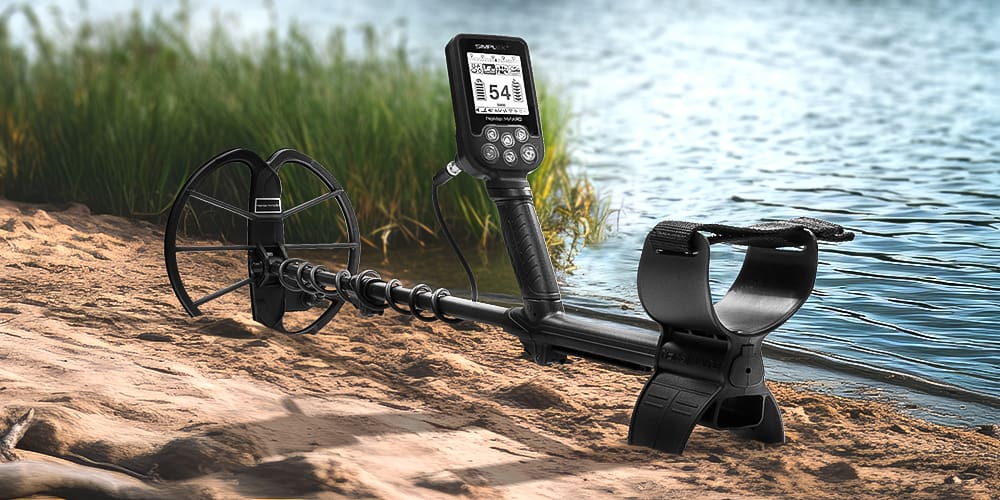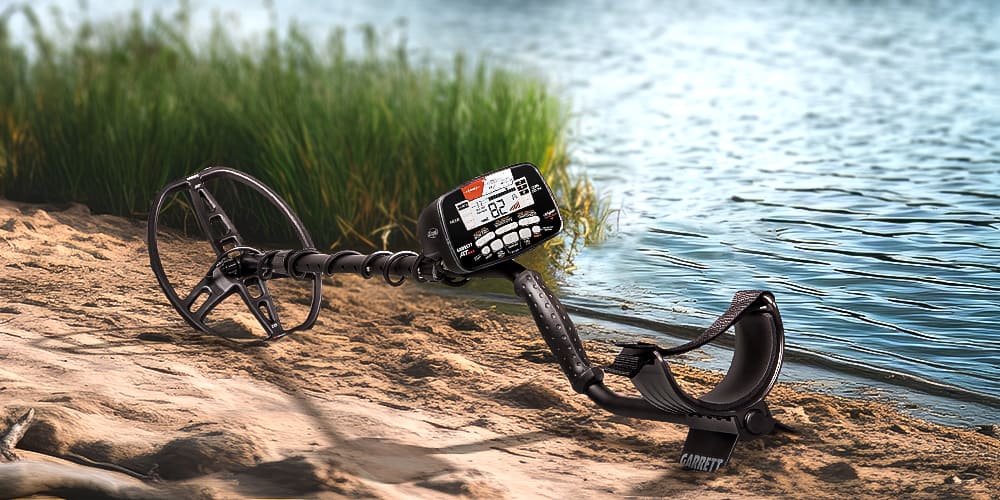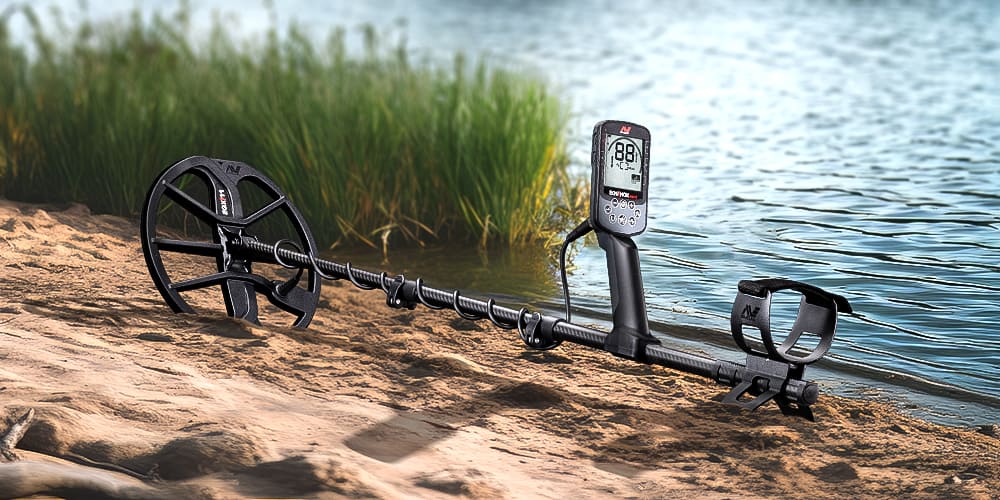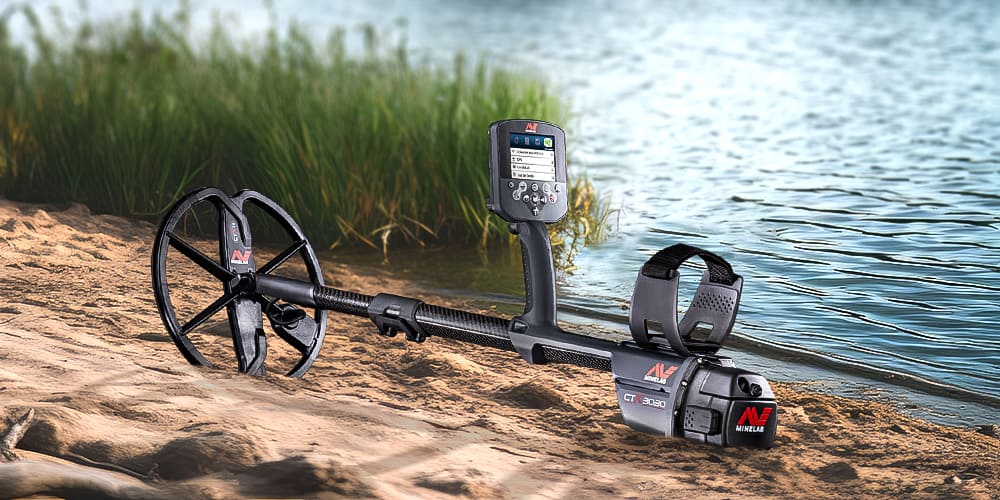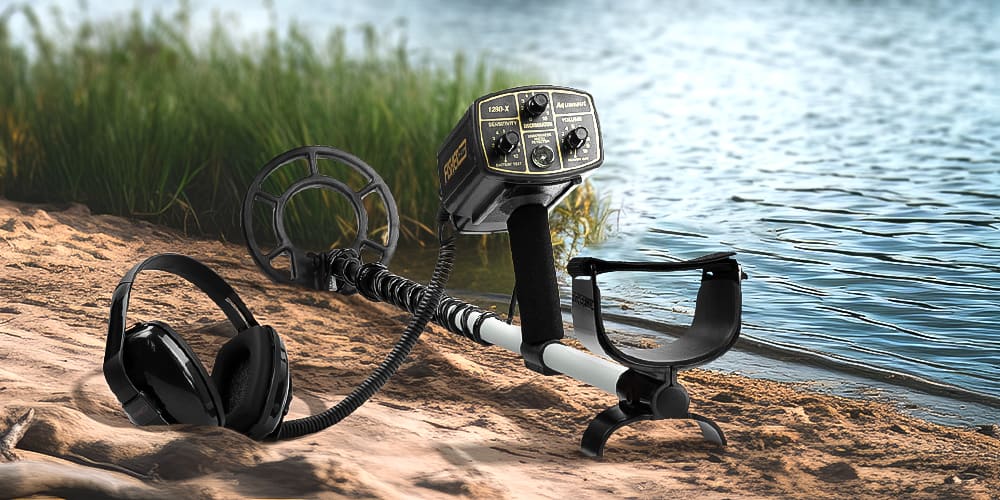If you’re planning to metal detect in freshwater environments, choosing the best underwater metal detector is crucial to increase your chances of success. This buyer’s guide aims to help you make an informed decision by providing a clear overview of the essential features and factors to consider when selecting a freshwater metal detector.
By focusing on practical aspects such as waterproofing, sensitivity, depth rating, and user experience, this guide will streamline your decision-making process, ensuring you find the ideal metal detector for your freshwater adventures.
Best Underwater Metal Detectors in 2024
- Nokta Simplex+: best for beginners or if you’re on a budget.
- Garrett AT Max: best mid-level option.
- Minelab Equinox 900: best value for higher end features.
- Minelab CTX 3030: best for high-end features.
- Fisher 1280x: best dedicated freshwater detector.
Note that this guide is only for underwater metal detecting in freshwater. For saltwater, see our guide to saltwater metal detectors.
Nokta Simplex+
Nokta Simplex+ is an affordable, versatile, and user-friendly metal detector that caters to both beginners and experienced users. Its fully submersible design, Iron Volume control, built-in wireless module, vibration mode, and frequency shift feature make it an excellent choice for freshwater environments.
Operating at 12 kHz, it offers a balance between detecting small targets and providing reasonable depth capabilities. However, it has some drawbacks such as limited depth capabilities compared to higher-end models and less refined discrimination, along with a few reported performance issues.
Pros:
- Affordable and user-friendly
- Fully submersible up to 3 meters (10 feet)
- Iron Volume control for improved target identification
- Built-in wireless module for seamless headphone connectivity
- Vibration mode for underwater detecting and noisy environments
- Frequency shift feature to minimize interference
- 12-hour rechargeable battery life
Cons:
- Limited depth capabilities compared to higher-end models
- Less refined discrimination
- Reported performance issues (ground balancing, target identification, sound problems, beach instability)
Garrett AT Max
Garrett AT Max is a high-performance metal detector, well-suited for freshwater detecting. Its waterproof design, Z-Lynk wireless technology, Iron Audio, and adjustable frequency settings enable a smooth and efficient experience in rivers, lakes, and ponds. While offering impressive features and depth capabilities, the AT Max comes with a higher price tag and may have a steeper learning curve for beginners.
Pros:
- High-performance and advanced features
- Fully submersible up to 3 meters (10 feet)
- Built-in Z-Lynk wireless technology for seamless headphone connectivity
- Iron Audio for improved target identification
- Adjustable frequency settings to minimize interference
- Impressive depth capabilities at 13.6 kHz operating frequency
Cons:
- Steeper learning curve for beginners due to advanced features and settings
- Some users have reported issues such as a constant high pitched tone, chatter, noise and erratic behavior, lack of volume control on iron signals and poor tonal quality.
Minelab Equinox 900
The Minelab Equinox 900 is a top-of-the-line metal detector, and a great option for freshwater metal detecting. It boasts exceptional performance, advanced features, and unparalleled capabilities in freshwater environments. Equipped with revolutionary Multi-IQ technology, the Equinox 900 delivers precise target identification, superior depth, and enhanced discrimination. I
ts lightweight and waterproof design allows for comfortable and hassle-free use in various underwater settings. However, the high-end performance comes with a higher price tag, making it a considerable investment for those looking to excel in freshwater metal detecting.
Pros:
- Exceptional performance with Multi-IQ technology, providing superior depth and target identification in freshwater environments.
- Waterproof up to 16 feet, allowing for versatile use in different underwater settings.
- High-resolution target IDs and adjustable iron bias for better target separation and trash discrimination.
- Eight search modes, including two gold prospecting modes, for versatile detection in freshwater environments.
- Ergonomically designed handle, lightweight construction, and collapsible design for comfortable and convenient use.
Cons:
- Higher price tag compared to other metal detectors, making it a significant investment for users.
Minelab CTX 3030
The Minelab CTX 3030, our top pick for freshwater metal detecting, offers exceptional performance and advanced features, but comes with a higher price tag. Its superior depth capabilities, accurate target identification, and customizable settings make it an excellent choice for serious hobbyists and professionals seeking a high-end device. Despite its cost, the CTX 3030’s unmatched performance in freshwater environments and overall versatility justify the investment.
Pros:
- Exceptional depth capabilities and accurate target identification
- Fully waterproof up to 3 meters (10 feet) for worry-free freshwater exploration
- Customizable settings for optimal performance in various environments
- GPS location tracking and mapping to easily revisit productive spots
- Wireless audio options for greater freedom of movement
- Multi-frequency technology enhances detecting capabilities
Cons:
- Most expensive option among the recommendations
- Heavier and bulkier compared to other models, potentially tiring during long sessions
- Steeper learning curve for beginners due to advanced features and settings
Fisher 1280x
The Fisher 1280X, a classic-style knob detector without a screen, is a reliable choice for freshwater metal detecting. Its straightforward design, robust waterproof construction, and ease of use make it suitable for both novices and experienced users. Although it lacks some modern features, its solid performance, long battery life, and durability provide excellent value for the price.
Pros:
- Classic-style knob detector, easy to operate with no screen
- Fully submersible up to 76 meters (250 feet), ideal for deeper freshwater exploration
- User-friendly design suitable for beginners and experienced users
- Solid performance in freshwater environments
- Long battery life of up to 75 hours
- Durable and built to withstand harsh conditions
Cons:
- Lacks some advanced features found in modern detectors
- Limited customization and settings compared to other models
- Not as sophisticated target identification and discrimination capabilities
Buyer’s Guide
As an experienced metal detecting enthusiast, I have spent countless hours exploring freshwater environments such as rivers, lakes, and ponds in search of hidden treasures. Over the years, I have gained in-depth knowledge and understanding of the different types of metal detectors, their capabilities, and the unique challenges presented by freshwater detecting.
My personal experience has allowed me to test various metal detectors and accessories, enabling me to distinguish between their performance, ease of use, and overall effectiveness.
This hands-on experience and expert knowledge form the foundation of my recommendations in this buyer’s guide, ensuring that the information provided is both accurate and valuable for anyone interested in freshwater metal detecting.
Here are all the things you need to consider when purchasing an underwater metal detector.
Metal Detecting in Water
There are several differences between metal detecting in freshwater and on land. Some of these differences include:
- Equipment: When metal detecting in freshwater, you will need a waterproof metal detector and other specialized equipment such as waterproof headphones, a scoop or sand rake, and potentially diving gear, depending on the depth of the water.
- Search Technique: On land, you can easily walk around and swing the metal detector’s coil close to the ground. In freshwater, you may need to use a different technique, like floating or wading, to maintain the proper distance between the coil and the waterbed. Additionally, you may need to move more slowly and methodically in water due to currents and buoyancy.
- Targets and Signals: The targets you find in freshwater environments may differ from those on land. Freshwater areas can contain relics or items that have been submerged for a long time, leading to more corrosion and mineral buildup. This can result in weaker or more inconsistent signals compared to those found on land.
- Digging and Recovery: Digging on land typically involves using a small shovel or hand trowel. In freshwater, you may need to use a sand scoop or your hands to move sand, rocks, or mud to recover your finds. Visibility can also be an issue in murky water, making it more challenging to locate and retrieve targets.
- Environmental Factors: Freshwater metal detecting can be affected by water temperature, currents, and water levels. Cold water can limit the amount of time you can spend detecting, while strong currents can make it difficult to maintain proper coil positioning. Fluctuating water levels can expose new areas for detecting or make previously accessible areas difficult to reach.
- Legal Considerations: Different rules and regulations may apply for metal detecting in freshwater compared to on land. Public lands, parks, or beaches may have specific rules for detecting in water, and you may need to obtain additional permits or permissions for freshwater metal detecting.
- Preservation: Items found in freshwater environments can be more fragile due to long-term exposure to water and sediment. Extra care should be taken when cleaning and preserving finds from these environments to prevent damage.
- Safety: Metal detecting in freshwater environments presents unique safety considerations, including the risk of drowning, hypothermia, and encounters with aquatic animals. It’s essential to take the necessary precautions and follow safety guidelines when detecting in water.
Overall, freshwater and land metal detecting each have their unique challenges and rewards, and the environments require different techniques and equipment to be successful.
Waterproof Depth Rating
The metal detector should have a specified depth rating, indicating how deep underwater it can be used without risking damage. Some models are only waterproof up to a certain depth, while others can be fully submerged for deeper searches. This guide does not cover any detectors that aren’t fully submersible.
User Skill Level
User skill level is essential when choosing a metal detector for freshwater environments. Entry-level detectors in the $150-300 range are ideal for beginners, as they offer simplicity and ease of use. As you gain experience, you may opt for advanced models with features like adjustable threshold, custom search modes, and GPS functionality. Avoid detectors below $150, as they are generally considered toys and not reliable for serious treasure hunting.
Price
Price is a crucial factor, especially for newcomers who may not be certain of their long-term interest in the hobby. Beginners should aim to spend between $150 and $300 on their first metal detector, offering enough functionality to generate interest and develop a passion for freshwater metal detecting.
Detection Technology
Very low frequency (VLF) technology is suitable for most freshwater environments and is found in detectors under $1,000. VLF detectors work well for coin, jewelry, and relic hunting in freshwater locations.
Key Technology Features Explained
When selecting a metal detector for freshwater environments, consider essential tech features such as operating frequency, sensitivity, discrimination, and ground balance. These features impact your detector’s overall performance, accuracy, and efficiency in freshwater metal detecting.
Search Coils
Choosing the right search coil is essential for success in freshwater environments. Coil size, type, and shape all play a role in performance, with smaller coils offering better target separation and sensitivity in mineralized ground. Consider ground conditions and mineralization when selecting a coil for freshwater metal detecting. Accessory coils can help adapt to different environments, such as rocky riverbeds or underwater searches.
Other Considerations
Detector weight is important for user comfort during extended treasure hunting sessions, especially if you have physical limitations. Opt for lighter models if necessary.
Battery life is crucial for uninterrupted treasure hunting. Consider the type of batteries used, the device’s optimization, and the detector settings when evaluating battery life.
Search modes help users differentiate between valuable finds and unwanted items in freshwater environments. Customizable search modes enhance target identification and create a tailored treasure hunting experience.
Audio output and headphone compatibility are important for detecting subtle audio cues in the field.
Waterproofing is particularly relevant in freshwater metal detecting, as detectors may be exposed to water or even submerged during the search. Ensure your detector has adequate waterproofing for your intended use.
Ergonomics affect user comfort and ease of use during long treasure hunting sessions.
GPS integration can be helpful for tracking locations and marking waypoints in freshwater environments.
Accessories like pinpointers, headphones, diggers, pouches, carry bags, and waterproof scoops can significantly improve your freshwater metal detecting experience.
Brand choice is critical when selecting a freshwater metal detector. Opt for reputable brands like Bounty Hunter, Fisher, Garrett, Minelab, Nokta Makro, Teknetics, and XP for quality and reliable customer support.
Warranty considerations are important when choosing a metal detector brand, with most brands offering warranties ranging from 2-5 years. Waterproof models may have shorter warranties (1-2 years). Verify warranty transferability if purchasing a used detector.
Final Thoughts
In conclusion, freshwater metal detecting offers a unique and rewarding experience for treasure hunters of all skill levels. The key to success in this fascinating hobby lies in selecting the right equipment, understanding the specific challenges of freshwater environments, and being persistent in your search for hidden treasures. This buyer’s guide has provided valuable insights and recommendations to help you choose the best underwater metal detector for your freshwater adventures, based on your preferences, skill level, and budget.
As you embark on your freshwater metal detecting journey, remember that patience, curiosity, and a willingness to learn are essential traits for success. Embrace the excitement of exploring new areas, uncovering long-lost relics, and connecting with history in a tangible way. With the right equipment, knowledge, and attitude, you’re sure to find hidden treasures and create unforgettable memories along the way. So, gear up, stay safe, and dive into the world of freshwater metal detecting – who knows what fascinating discoveries await you beneath the surface?

